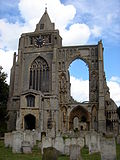| Abbots of Crowland
|
| Incumbent
|
Dates
|
Notes
|
| Thurcytel
|
ca 948—ca975
|
According to the History of Ingulf, the abbey was reformed and refounded in 948, with Thurcytel leaving the service of King Eadred to become its first new abbot.[1] The same claims he died in 975.[1]
|
| Ægelric I
|
fl. late 10th century
|
Ægelric was, according to Orderic Vitalis, Thurcytel's nephew.[2]
|
| Ægelric II
|
fl. late 10th century/
early 11th century
|
Like Ægelric I, Ægelric II was supposedly a relative of Thurcytel.[2]
|
| Osketel
|
fl. ca 1012
|
Supposedly died on 7 October.[2]
|
| Godric
|
fl. early 11th century
|
Orderic Vitalis gives his death as 19 January.[3]
|
| Wulfgeat
|
fl. early-to-mid-11th century
|
According to Orderic Vitalis, he was Abbot of Peakirk and had permission from Edward the Confessor to hold both abbeys at once.[3] Died on 7 July.[3]
|
| Leofric of Peterborough
|
fl. mid-11th century
|
According to the Peterborough Chronicle Leofric held Crowland along with four other abbeys.[3]
|
| Wulfketel
|
ca 1061—1085x6
|
Orderic claims that he appointed abbot by Edward the Confessor and Abbot Leofric, and that he was abbot for 24 years.[3] He died at the Gloucester Christmas court of William the Conqueror, in either December 1085 or January 1086.[3] The 'abbot Ulfketyl' of Charles Kingsley novel "Hereward the Wake'".
|
| Ingulf
|
1085x6—1109
|
Died 16 November, probably in 1109, as he was said to have been abbot for 24 years (see Wulfketel & Geoffrey d'Orleans notes).[3]
|
| Geoffrey d'Orleans
|
1109—ca 1124
|
Orderic says he was born at Orleans, was prior of St Évroult in Normandy, being appointed abbot of Crowland in 1109, holding for 15 years before dying on 5 June (probably 1124).[3]
|
| Waltheof
|
ca 1126—1138
|
According to Orderic, he was the "brother of the nobly born Englishman Gospatric",[4] thought to mean that he was the son of Gospatric, Earl of Northumbria (the brother being Gospatric II, Earl of Lothian).[5]
|
| Godfrey
|
1138x9—1143
|
Prior of St Albans, electet abbot of Crowland in December 1138 or soon after, and died on 6 April 1143.[3]
|
| Edward
|
1143—1173
|
Died on 19 January 1173; after death, the abbey was vacant until sometime after 8 July 1175.[3]
|
| Robert
|
1175—1189x90
|
Monk of Reading Abbey, became prior of Leominster, and was appointed abbot of Crowland in the second half of 1175, allegedly remaining abbot for 15 years.[3] His last historical appearance is 3 September 1189, and died on either 17 March or 24 March 1190.[3]
|
| Henry de Longchamp
|
1190—1236
|
William de Longchamp, Bishop of Ely, he held the abbey for 46 years, dying in 1236.[6]
|
| Walter de Weston
|
el. 1236
|
Monk of Crowland, receives royal consent to hold abbey on 28 September 1236, but was elected against church rules and election was quashed.[6]
|
| Richard
|
1236—1248
|
He was the cellarer of Bardney Abbey before being appointed to abbey by Robert Grosseteste, Bishop of Lincoln, who had authority from the Church to make such an appointment.[6] He died 17 June 1248.[6]
|
| Thomas de Welle
|
1248—1254
|
A monk of Crowland, sometime sub-prior, he was abbot after Richard's death and held abbey for 6 years, dying on either 8 October or 15 October 1254.[6]
|
| Ranulf de Merche
|
1254—1280
|
Another monk of Crowland, after becoming abbot he ruled for 26 years.[6]
|
| Richard de Crowland
|
1280—1303
|
Monk of Crowland, elected 27 October 1280, election quashed but appointed anyway by the Bishop of Lincoln, Oliver Sutton.[6]
|
| Simon de Luffenham [Suthluffenham]
|
1303—1324
|
He was another abbot from the Crowland monks. He held the abbey for 21 years, notably attending the Council of Vienne in 1311, and dying sometime in 1324.[6]
|
| Henry de Casewick
|
1324—1359
|
He was prior of Crowland before becoming abbot in 1324.[6] The abbey suffered from great poverty during his abbacy, coming under the supervision of the crown, the Archbishop of Canterbury and the Earl of Northampton.[6] He died early in 1359.[6]
|
| Thomas de Barnack
|
1359—1378
|
A monk of Crowland, he was elected for presentation to the bishop of Lincoln and confirmed by the latter in 1339.[6] After a 14 year abbacy, he died on 12 March 1378.[6]
|
| John of Ashby
|
from 1378
|
He became abbot in 1378.[7]
|
| Thomas of Overton
|
from 1392
|
He became abbot in 1392.[7]
|
| Richard Upton
|
from 1417
|
He became abbot in 1417.[7]
|
| John Litlington
|
from 1427
|
He became abbot in 1427.[7] He was licensed by Letters Patent of King Henry VI to acquire a site so that a hostel could be established in Cambridge for student-monks. This hostel was to become Buckingham College and eventually Magdalene College.[8]
|
| John of Wisbech
|
from 1470
|
He became abbot in 1470.[7]
|
| Richard Crowland
|
from 1476
|
He became abbot in 1476.[7]
|
| Lambert Fossdyke
|
from 1484
|
He became abbot in 1484.[7]
|
| Edmund Thorpe
|
from 1485
|
He became abbot in 1485.[7]
|
| Philip Everard
|
from 1497
|
He became abbot in 1497.[7]
|
| William Gedding
|
from 1504
|
He became abbot in 1504.[7]
|
| Richard Bardney
|
from 1507
|
He became abbot in 1507.[7]
|
John Wells
(alias John Bridges)
|
1512—1539
|
Wells was the last abbot, ruling the abbey from 1512 until he was forced to hand it over to the king's agents in 1539, after the Second Act of Dissolution.[7]
|
